| Page last updated
15 May 2009 |
What's New with the MUSSELp?
The highlights of 2008.
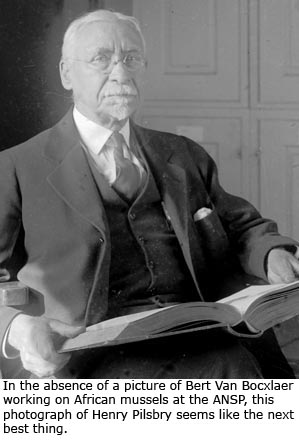 26 October - 15 November 2008. -- Bert Van Boxclaer visits the Academy of Natural Sciences as a Jessup Fellow to study African freshwater mussels with DLG. Over the course of his tenure at the ANSP, DLG aquired a large collection of African freshwater mussels in his office: some from recent collecting, some from the holdings of the ANSP, and others on loan from such fantastically generous institutions as the University of Michigan Museum of Zoology, Harvard's Museum of Comparative Zoology and the Field Museum of Natural History. Those specimens formed the basis of Bert's studies. In his own words: 26 October - 15 November 2008. -- Bert Van Boxclaer visits the Academy of Natural Sciences as a Jessup Fellow to study African freshwater mussels with DLG. Over the course of his tenure at the ANSP, DLG aquired a large collection of African freshwater mussels in his office: some from recent collecting, some from the holdings of the ANSP, and others on loan from such fantastically generous institutions as the University of Michigan Museum of Zoology, Harvard's Museum of Comparative Zoology and the Field Museum of Natural History. Those specimens formed the basis of Bert's studies. In his own words:
"During Fall 2008, Bert Van Bocxlaer finally visited the ANSP in a Jessup Award program with DLG as host. Both parties had been planning this meeting for a long time, but never managed to synchronise schedules before. The main aim of this visit was to study the modern diversity of Iridinid mussels, in particular of those species that belong, or are considered to belong to Mutela sensu lato. Apart from the ANSP collections also material of the UMMZ and the MCZ, on loan to
DLG, was incorporated. In the wealth of the old literature and specimens, the shell morphology of the extant organisms was studied. As such, we initiated connecting the modern diversity with the Late Cenozoic fossil bivalve record. Although these efforts must appear ordinary in the layman'?s eyes, several major shifts in shell morphology, mainly in hinge dentition, have taken place in the recent past. Not only do these shifts complicate our final goal of building an acceptable phylogenetic hypothesis based on a combined paleontological and neontological data set, also their causality is puzzling. A better insight in the triggering factors could shed a different light on the natural history of the Late Cenozoic malacofauna of Africa." |
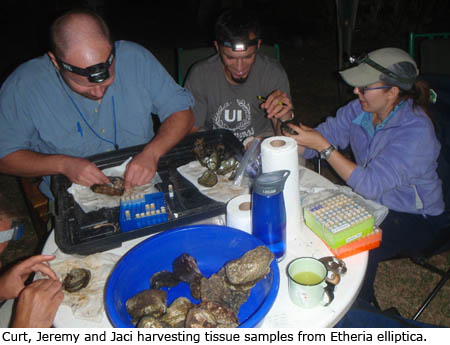 9 September-1 October 2009. -- The MUSSELp et al. make a low-water excursion to the Upper Congo Basin. For almost the entire month of September, DLG, KSC and four other American researchers and students sampled freshwater mussels in Zambia. Many of the same collecting sites had also be examined in May 2007 during higher water conditions. Coming in during the tail-end of the dry season as we did provided new (and better) sampling opportunites for freshwater mollusks, and we made a good haul, representing almost all of the known freshwater mussel species of the region in the families Etheriidae, Iridinidae and Unionidae. Click here to learn more about our collecting sites. 9 September-1 October 2009. -- The MUSSELp et al. make a low-water excursion to the Upper Congo Basin. For almost the entire month of September, DLG, KSC and four other American researchers and students sampled freshwater mussels in Zambia. Many of the same collecting sites had also be examined in May 2007 during higher water conditions. Coming in during the tail-end of the dry season as we did provided new (and better) sampling opportunites for freshwater mollusks, and we made a good haul, representing almost all of the known freshwater mussel species of the region in the families Etheriidae, Iridinidae and Unionidae. Click here to learn more about our collecting sites.
The second agenda of our trip was to broaden the impacts of MUSSELp research by providing an opportunity for uninitiated mollusk-folks to get wet in Africa. In addition to DLG and KSC, we were joined by Curt Elderkin (assistant professor at The College of New Jersey), Anthony Geneva (lab manager of the LMSE@ANSP), Jeremy Tiemann (field biologist at the Illinois Natural History Survey) and Jaclyn Kahn (sophomore at Rutgers University).
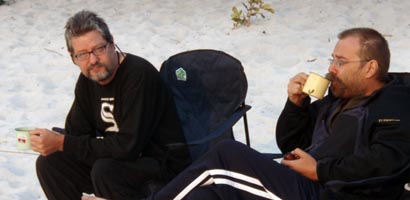
KSC & DLG
|
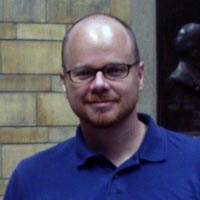
Curt Elderkin
|

Anthony Geneva
|

Jeremy Tiemann
|
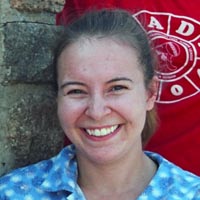
Jaclyn Kahn
|
Besides enjoying the chance to further the scientific objectives of the MUSSEL Project (this web site), this was also an opportunity to introduce some newbies to different people and cultures, the logistics of organizing an international collecting expedition, anti-malarial prophylaxis and driving on the left. Curt set up the official blog for the trip, and Jeremy kept one of his own.
We didn't just decide on a whim to pack up and head to Zambia. In fact, this specific trip had been in the planning for almost a year, and that time was used to coordinate with the Zambian authorities and to secure additional funding. We would specifically like to acknowledge:
 Alex Chilala. — Mr. Chilala is the principle fisheries officer for Lusaka Province and an all-around good guy. On this trip (as with all of our previous trips to Zambia), he was invaluable for leading or collecting and export permit applications through the necessary channels, for helping arrange lodging and other necessities, for shuttling our group around Lusaka on various errands, for miraculously finding lab-grade ethanol in Kasama, and for his general good humor. Alex Chilala. — Mr. Chilala is the principle fisheries officer for Lusaka Province and an all-around good guy. On this trip (as with all of our previous trips to Zambia), he was invaluable for leading or collecting and export permit applications through the necessary channels, for helping arrange lodging and other necessities, for shuttling our group around Lusaka on various errands, for miraculously finding lab-grade ethanol in Kasama, and for his general good humor.- C.T. Maguswi, Director of Fisheries, Zambian Ministry of Agriculture & Cooperatives. — It is because of Mr. Maguswi and his openness to collaboration between American and Zambian scientists that we can count this trip a success.
- The National Science Foundation. — Major funding for this expedition was provided by the NSF, including an ROA supplement so that we could bring Curt Elderkin and (at least partially) fund his phylogeographic research on the samples we collected.
Click on the pictures below to see larger versions. They depict the throng watching us on the Kulungu River, an ampullariid in Lake Bangweulu, a rhino in Mosi-oa-Tunya Park, Victoria Falls at sunset, a goat-meat stand near Mazabuka and CROCS!
|
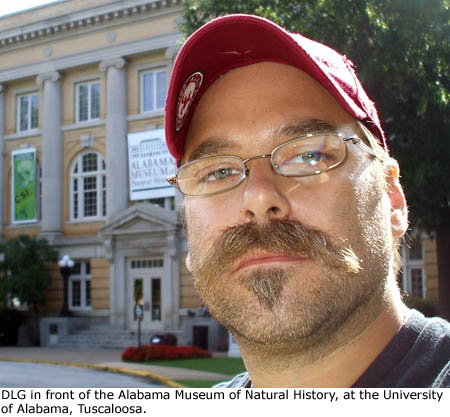 16 August 2008. -- DLG takes up a new position at the University of Alabama in Tuscaloosa. DLG has begun the transtion to his new seat of operations, the University of Alabama in Tuscaloosa. After serving as a curator for more than 6 years at the Academy of Natural Sciences in Philadelphia, he has moved to academia as part of the Bama Biology faculty. 16 August 2008. -- DLG takes up a new position at the University of Alabama in Tuscaloosa. DLG has begun the transtion to his new seat of operations, the University of Alabama in Tuscaloosa. After serving as a curator for more than 6 years at the Academy of Natural Sciences in Philadelphia, he has moved to academia as part of the Bama Biology faculty.
This fall 2008 term will be one of transition, as DLG continues to work a couple projects through the ANSP. In September he will be leading an expedition to Zambia (again) and in October, working with a Jessup Fellow studying African freshwater mussels. And this web site will continue to be hosted by the ANSP.
Click here to see DLG's Bama Home Page. |
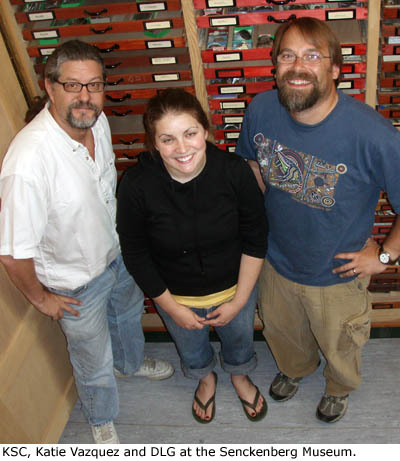 6-12 July 2008. -- DLG, KSC and Katie Vazquez visit the Senckenberg Museum in Frankfurt, Germany. DLG, KSC and Katie Vazquez met up in Frankfurt, putting aside the various other projects on which they have been working, to capture specimen data from the Senckenberg Museum — a collection heavy with all kinds of freshwater mussel types. We had no museum visits in 2007, and this will probably be our only one for 2008. Moreover, this visit to the Senckenberg marks the end of our five-year tour of collections funded by the NSF. During our week in Frankfurt, we captured digital images and text data from more than 1250 specimen lots, bringing the current specimen holdings of the MUSSEL Project Database to 16,470 records. 6-12 July 2008. -- DLG, KSC and Katie Vazquez visit the Senckenberg Museum in Frankfurt, Germany. DLG, KSC and Katie Vazquez met up in Frankfurt, putting aside the various other projects on which they have been working, to capture specimen data from the Senckenberg Museum — a collection heavy with all kinds of freshwater mussel types. We had no museum visits in 2007, and this will probably be our only one for 2008. Moreover, this visit to the Senckenberg marks the end of our five-year tour of collections funded by the NSF. During our week in Frankfurt, we captured digital images and text data from more than 1250 specimen lots, bringing the current specimen holdings of the MUSSEL Project Database to 16,470 records.
Besides shooting shell pics, we have been using the summer of 2008 to make progress on other research fronts as well. Katie has been spending her break from Montclair State University to work in the LMSE @ ANSP with Anthony Geneva. The two of them are generating all kinds of freshwater mussel DNA sequences, which will be employed gainfully to problems of freshwater mussel systematics in the very near future. KSC has been trudging the uphill slog against a comprehensive review of North American freshwater bivalves, and DLG will have spent the better part of the summer months in Paris stirring up the ghosts of the Nouvelle Ecole. Watch this space as we continue to roll out the products of our research on this web site, http://www.mussel-project.net/. |
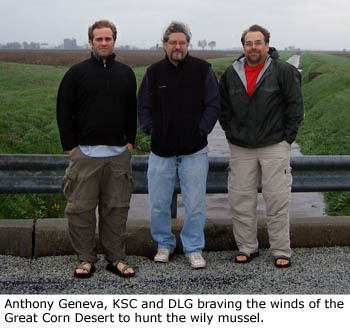 9-13 May 2008. -- DLG and Anthony Geneva Take a Road Trip to Illinois and Michigan. Over the weekend, DLG and Anthony Geneva of the LMSE @ ANSP hit the road on a whirl-wind trip through the Heartland to collect outgroup specimens. "Whirl-wind" is apt, as the weather conspired largely conspired against our efforts, but at least Anthony was able to get wet for the first time in the name of freshwater malacology. 9-13 May 2008. -- DLG and Anthony Geneva Take a Road Trip to Illinois and Michigan. Over the weekend, DLG and Anthony Geneva of the LMSE @ ANSP hit the road on a whirl-wind trip through the Heartland to collect outgroup specimens. "Whirl-wind" is apt, as the weather conspired largely conspired against our efforts, but at least Anthony was able to get wet for the first time in the name of freshwater malacology.
Anthony and DLG first drove from Philadelphia to Urbana to meet up with KSC in Urbaba. It has been a BUSY year for the MUSSEL Project, but this was the first time that we could get together in 2008 to do any collecting. For the most part, collecting conditions were poor, but we managed to score a few useful specimens for our systematic research.
From Urbana, DLG and Anthony moved on to Ann Arbor and the University of Michigan Museum of Zoology to collaborate on further collecting with Diarmaid Ó Foighil. The Huron River in Michigan was nearly as harsh as the tributaries Sangamon Basin, and all we collected on that leg of the trip was a bit of junkshell — and possibly pneumonia.
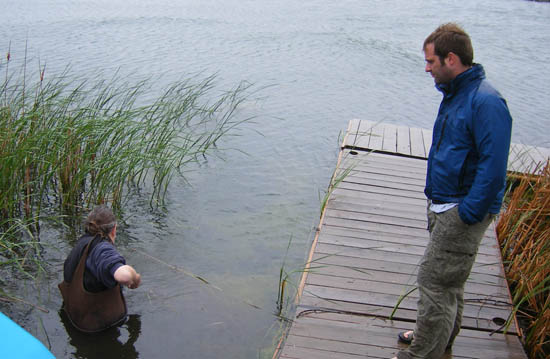
KSC and Anthony Geneva sampling a Pyganodon grandis sweet-spot.
|
|